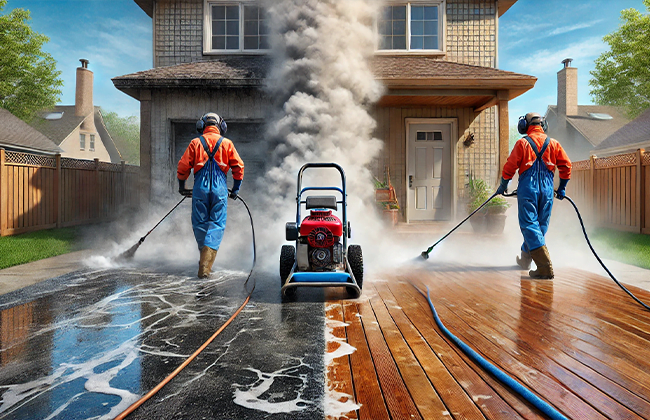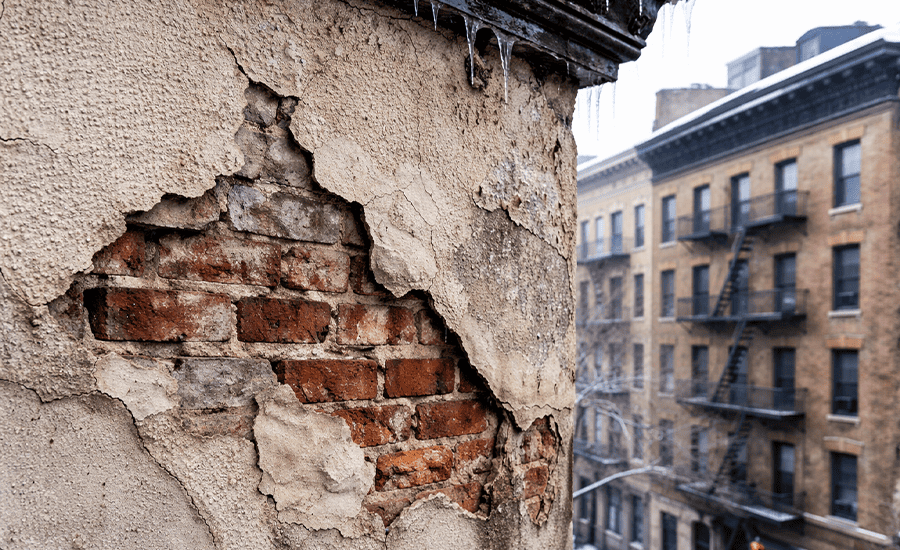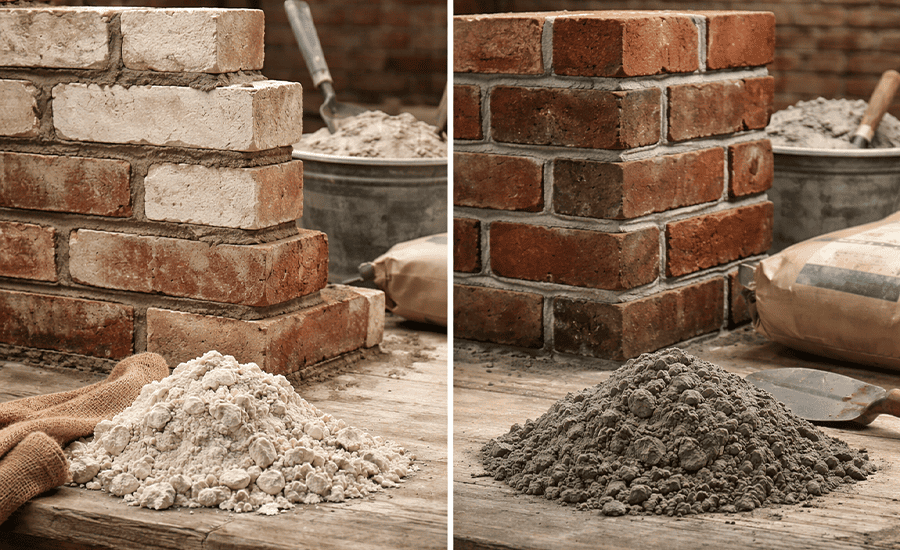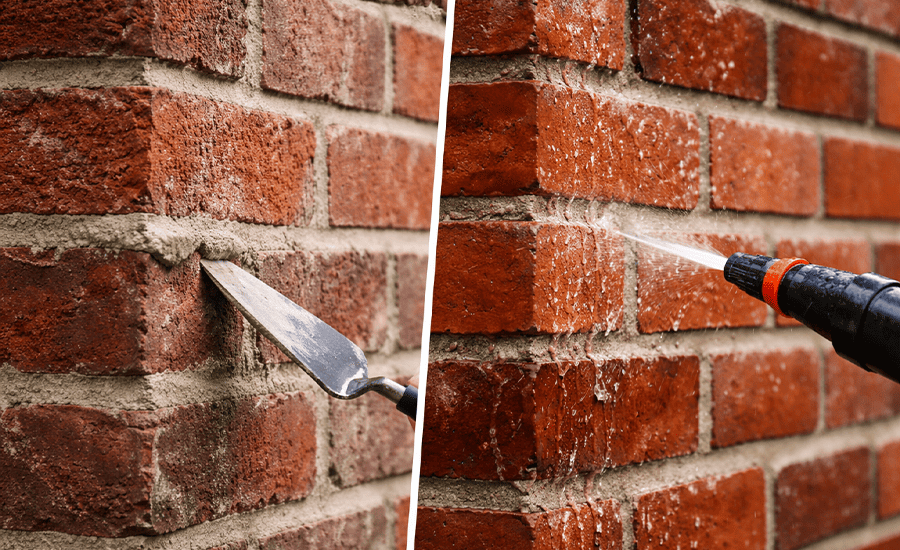Are you considering “Power vs Pressure Washing” for your home or business?
These powerful cleaning methods can transform the appearance of your property, tackling dirt, grime, and stubborn stains more effectively than conventional methods. Whether it’s reviving your driveway, siding, or other outdoor areas, understanding the unique advantages of power and pressure washing is key to achieving pristine results.
What is Power Washing?
Power washing, often mixed up with pressure washing, actually has a twist: it uses hot water to blast away dirt, grime, and stubborn stains. This method is perfect when you’re dealing with really tough-to-clean surfaces where grease, salt, and mildew play stubborn guests. From stripping old paint from decks to cleaning oily driveways, power washing is like giving your property a deep clean that regular washing can’t match.
Definition and Uses
Power washing uses heated water that enhances the cleaning process, making it highly effective against resilient stains and built-up debris. This approach is particularly useful for surfaces that can withstand high pressure and temperature, making it a favorite for both residential and commercial cleaning tasks. It’s also a preferred method for preparing surfaces for painting or refinishing, as it strips away old paint and deep-seated dirt efficiently.
Types of Machines and Technologies Used
The equipment used in power washing includes high-capacity machines capable of heating and ejecting water at pressures typically over 3,000 PSI. These machines incorporate advanced technology with features like adjustable thermostats to control water temperature and multi-nozzle options to adjust the water pressure and spray pattern according to the cleaning requirements.
Common Applications and Benefits
Power washing is the go-to choice for several tough cleaning jobs. Here are some places where it really shines:
- Residential Use: Great for cleaning siding, driveways, and patios. It can also prep surfaces for painting or sealing by removing old flaking paint or deep-set stains.
- Commercial Use: Used widely to clean buildings, walkways, and other commercial properties where appearances matter a lot and dirt accumulates heavily.
- Industrial Use: In industrial settings, power washing helps clean large machinery, warehouses, and can even remove grease and oil spills.
The benefits? Well, aside from making surfaces look new, power washing also increases the lifespan of your property by preventing decay and wear caused by accumulated dirt and organic material. It’s a powerful cleaning method that not only enhances curb appeal but also maintains hygiene and safety standards, especially in places where grime and pollutants are common.
Next, let’s move on to understanding what pressure washing entails and how it compares to the mighty power washing.
What is Pressure Washing?
Pressure washing, unlike its cousin power washing, uses cold water under high pressure to clean surfaces. It’s incredibly effective for blasting away dirt and debris without the need for hot water. This technique is particularly valuable for handling various cleaning tasks where high temperatures might damage the surface.
Explanation of the Technique
Pressure washing relies purely on the force of water hitting the surface with significant power to dislodge dirt and clean effectively. The cold water is pumped through a high-pressure hose with a specially designed nozzle that increases the velocity of the water, providing the cleaning power. This method is ideal for surfaces that are sensitive to heat but need deep cleaning, like painted surfaces, wood decks, and tiled areas.
Varieties of Pressure Washers
There are several types of pressure washers, each suited to different tasks:
- Electric Pressure Washers: These are quieter, lighter, and perfect for light residential use such as cleaning cars, small decks, and patios.
- Gas Pressure Washers: These offer more power and mobility, suitable for both residential and commercial use, capable of handling larger areas and tougher grime.
- Professional Pressure Washers: Designed for commercial and industrial use, these machines can handle continuous use and come with various features like adjustable pressures, flow rates, and hot water options.
Typical Uses in Residential and Commercial Settings
Pressure washing finds its way into numerous cleaning scenarios:
- Residential: From cleaning gutters and windows to refreshing grout on tiled patios, pressure washing is a favorite for home maintenance.
- Commercial: Businesses use it to maintain clean exteriors, such as restaurant patios, parking lots, and commercial garages, ensuring these areas are not only clean but also safe from slip hazards due to accumulated dirt or oil.
By understanding the powerful impact of pressure washing, homeowners and business owners can maintain their properties efficiently. Keeping these distinctions in mind, let’s delve into a comparative analysis of power washing versus pressure washing to determine which method might be more appropriate for specific cleaning tasks. This thoughtful exploration leads us seamlessly into the upcoming section titled Power vs Pressure Washing: Key Differences, where we’ll uncover the unique strengths and applications of each method.
Power vs Pressure Washing: Key Differences
When choosing between power washing and pressure washing, it’s not just about what’s available—it’s about selecting the right tool for the job based on key differences that affect performance and outcomes.
Heat Usage
The fundamental difference lies in the use of heat. Power washing employs heated water, making it exceptionally effective at removing substances like oil, grease, and stubborn stains. This heat can help sanitize surfaces as well, which is a bonus in areas needing disinfection. On the other hand, pressure washing uses unheated water and relies solely on the force of the water pressure, making it suitable for surfaces that might be damaged by high temperatures.
Pressure Settings
Both power and pressure washers come with adjustable settings, but the range and impact of these settings can vary significantly. Power washers usually operate at higher pressures because the hot water is effective at breaking down dirt, which can be beneficial for very dirty or grimy surfaces. Pressure washers might need a bit more finesse, especially on surfaces that are prone to damage.
Suitability for Different Surfaces
Choosing between power and pressure washing often comes down to the surface material involved. Power washing, with its combination of high heat and pressure, is ideal for more resilient surfaces like concrete, brick, and other hard substances that are not easily damaged. It’s particularly good for areas with oil or grease. Pressure washing is preferable for softer or more delicate surfaces like wood, certain types of siding, and vehicles, where high heat could cause damage or discoloration.
Understanding these differences is crucial for anyone looking to maintain or clean their property effectively. With this knowledge, you can choose the method that best suits your needs, ensuring your cleaning efforts are as efficient and safe as possible. Next, we’ll explore the Pros and Cons of Power Washing to see how this method measures up in various cleaning scenarios.
Pros and Cons of Power Washing
Power washing is a potent cleaning tool, offering several benefits but also requiring careful consideration of its potential drawbacks.
Detailed Advantages
Power washing isn’t just about blasting away dirt; it’s a comprehensive cleaning solution that offers multiple benefits across various applications:
- Effective Against Tough Grime: The combination of high pressure and hot water makes power washing incredibly effective at removing tough stains like grease, oil, and mildew.
- Sanitizing Capabilities: The hot water used in power washing can also kill bacteria and mold, making it an excellent choice for sanitizing areas such as outdoor kitchens, bathrooms, and pool areas.
- Time-Efficient: Because it’s so powerful, power washing can clean surfaces much faster than traditional methods, saving you time and effort.
- Reduces Allergens: By effectively removing mold, pollen, and other allergens from exteriors, power washing can improve air quality around your home.
- Prepares Surfaces: It’s great for preparing surfaces for painting or sealing, as it removes old paint and debris thoroughly and quickly.
Potential Drawbacks and When to Avoid
While power washing offers significant advantages, there are situations where its use might be inappropriate or even detrimental:
- Can Cause Damage: The high pressure and temperature can damage soft or delicate surfaces such as soft wood, old brickwork, or painted surfaces if not handled correctly.
- Requires Skill to Operate: Incorrect use can lead to uneven cleaning or even injuries. It’s often best left to professionals.
- Not Environmentally Friendly: Power washing typically uses a lot of water, and the runoff can include harmful chemicals, especially if cleaning chemicals are used in the process.
- Energy Intensive: It requires more energy to heat the water, making it less energy-efficient than cold water pressure washing.
With these insights into the pros and cons of power washing, you can better decide when and where to use this method effectively. Let’s now shift our focus to the Pros and Cons of Pressure Washing to see how it contrasts with power washing and when it might serve as a better alternative.
Pros and Cons of Pressure Washing
Pressure washing is a dynamic and effective cleaning method favored for its adaptability and efficiency, but it’s crucial to understand its full range of benefits and potential drawbacks to harness its capabilities effectively.
Benefits for Various Cleaning Tasks
Pressure washing stands out for its exceptional versatility and effectiveness across diverse cleaning environments:
- Versatility: It’s highly effective on a variety of surfaces including vinyl siding, brick facades, and concrete driveways, making it adaptable for both home and commercial settings.
- Water Efficiency: This method is notable for its efficient use of water. High pressure means that less water is needed to achieve better results compared to conventional cleaning techniques, making it a more sustainable choice.
- Chemical-Free Cleaning: Many pressure washing tasks can be completed without the need for harsh chemicals. The sheer force of the water is often enough to dislodge grime and dirt, which is not only better for the environment but also safer for people and pets around the cleaning area.
- Accessibility and Convenience: Pressure washing equipment is generally more user-friendly, portable, and easier to store than its heavier counterparts. Moreover, it is readily available for rent or purchase at reasonable prices, providing accessibility to both professionals and DIY enthusiasts.
- Preventive Maintenance: Regular cleaning with a pressure washer can prevent the accumulation of harmful substances such as mold, algae, and dirt that can degrade surfaces over time, thereby extending the lifespan of your property’s exterior elements.
Limitations and Precautions
While pressure washing is highly beneficial, there are important considerations and precautions to keep in mind:
- Risk of Surface Damage: High-pressure water streams can be too harsh for delicate surfaces like soft wood, old plaster, or peeling paint, potentially leading to damage if not adjusted correctly.
- Skill and Technique: The effectiveness of pressure washing greatly depends on the operator’s skill. Inexperienced handling can lead to uneven cleaning, or worse, surface damage. Adequate training or practice is recommended to master the technique.
- Environmental Impact: Although typically more eco-friendly than methods involving heavy chemicals, the runoff from pressure washing can still carry pollutants away from the cleaned surfaces into surrounding soil or waterways. Careful consideration of where and how to direct runoff is necessary to minimize environmental impact.
- Weather Sensitivity: Its performance can be impacted by weather conditions. For instance, using pressure washing in freezing temperatures can lead to water freezing in the equipment or on the surface, causing damage and potential hazards.
Understanding these pros and cons will equip you to make more informed decisions about when and how to use pressure washing effectively. As we consider these points, it’s clear that the choice between pressure washing and power washing depends on specific needs and circumstances. Now, let’s move forward and discuss How to Choose Between Power and Pressure Washing. We’ll focus on selecting the best method for your specific cleaning requirements and environmental conditions.
How to Choose Between Power and Pressure Washing

Choosing the right washing method is crucial for effective cleaning and preserving the integrity of your surfaces. Here’s how you can make an informed choice between power and pressure washing based on various important factors.
Factors to Consider
Before diving into the cleaning process, it’s important to evaluate a few key aspects to ensure you choose the method that suits your needs best:
- Surface Type: Power washing is ideal for concrete and other hard surfaces that can withstand high pressure and temperature. On the other hand, pressure washing is better for softer or painted surfaces that could be damaged by heat.
- Dirt Level: The level of dirtiness can also guide your choice. Power washing is superior for removing ingrained grime and oily stains, whereas pressure washing is sufficient for lighter, surface-level dirt.
- Environmental Considerations: If you’re conscious about environmental impact, pressure washing might be preferable as it generally uses less water and can often be done without chemicals.
- Area Size: Consider the size of the area you need to clean. Larger, more open areas might benefit from the swift efficiency of power washing, while smaller or more detailed spaces might require the gentler touch of pressure washing.
Tips on Selecting the Right Service or Equipment
Choosing the right equipment or service is just as crucial as selecting the method. Here’s how to ensure you get the best fit for your cleaning needs:
- Assess the Job Requirements: Clearly define what needs to be cleaned to help decide whether to rent or buy equipment, or hire a professional service.
- Research Equipment Options: Investigate different models and types. Features to look for include adjustable pressures, various nozzles for different spray types, and, in the case of power washers, heating capabilities.
- Consider Rental Options: For infrequent use, renting might be more cost-effective and convenient than buying. Check local shops for availability and rates.
- Read Reviews and Seek Recommendations: Use reviews and recommendations to gauge the effectiveness and reliability of both equipment and professional services. Online forums and local community boards can be great resources.
With these insights, you’re better equipped to choose between power and pressure washing. Your choice can be based on specific needs and the nature of your cleaning project. Next, we will look at Safety Tips for Power and Pressure Washing. This ensures you handle whichever method you choose safely and effectively.
Safety Tips for Power and Pressure Washing
Ensuring safety while using power or pressure washers is crucial not only to protect yourself but also to maintain the longevity of the surfaces you’re cleaning. Here are some essential tips and common pitfalls to watch out for.
Best Practices
Safety starts with knowing how to handle your equipment correctly and what precautions to take:
- Read the Manual: Always start by reading the manufacturer’s manual. Different models have specific operating instructions and safety warnings.
- Wear Protective Gear: Use goggles to protect your eyes from debris, gloves to shield your hands, and non-slip shoes to prevent falls on wet surfaces.
- Secure the Area: Ensure the cleaning area is clear of pets, children, and bystanders who might accidentally get into the line of spray.
- Check for Hazards: Before starting, remove any electrical hazards or tripping risks such as loose cords or garden hoses from the area.
- Use the Right Nozzle: Select the appropriate nozzle for the job to avoid damaging the surface or causing accidental injuries due to excessive pressure.
Common Safety Mistakes and How to Avoid Them
Awareness of common errors can help prevent accidents and ensure a smoother cleaning experience:
- Ignoring Weather Conditions: Don’t use power or pressure washers during adverse weather conditions like high winds or lightning storms, which can increase the risk of accidents.
- Overreaching or Overextending: Avoid using ladders or overreaching while operating a washer. High pressure can cause kickback, leading to falls or loss of control.
- Neglecting Maintenance: Regularly check and maintain your washer. Ensure all connections are secure and that there are no leaks or damaged hoses, which can pose serious risks.
- Forgetting Water Supply Issues: Always ensure your water supply is adequate for your washer’s needs. An inadequate water supply can damage the pump and lead to malfunctions.
- Improper Handling of Chemicals: If you’re using detergents or chemicals, handle them with care. Use only washer-safe chemicals and store them properly to avoid spills and reactions.
By adhering to these safety guidelines, you can effectively minimize risks associated with power and pressure washing. Next, let’s explore Maintenance and Care for Your Washer to keep your equipment in top condition, ensuring it’s ready and safe for each use.
Maintenance and Care for Your Washer
Proper maintenance is not just about keeping your power or pressure washer functioning efficiently. It’s about ensuring its longevity, safety, and optimal performance over time. Here’s how to implement thorough routine checks and offer effective upkeep. Along with this, we’ll provide tips to prolong the life of your machine.
Routine Checks and Upkeep
Maintaining your washer requires attention to detail and a commitment to regular care:
- Pre-Use Inspection: Before each use, perform a comprehensive check for any signs of wear, tears, or leaks, especially in the hoses, connections, and nozzles, which are susceptible to damage from regular use.
- Clean Filters and Nozzles Regularly: Debris and mineral deposits can build up in filters and nozzles, potentially clogging them and reducing performance. Cleaning these components after each use ensures that your washer operates at peak efficiency.
- Monitor Oil and Fuel Levels: For gas-powered models, it’s vital to check oil levels regularly, change the oil according to the manufacturer’s guidelines, and use fresh fuel to prevent engine problems. For electric models, ensure that all electrical connections are secure, and inspect cords for fraying or damage to prevent electrical hazards.
- Proper Storage: After use, thoroughly drain all water from the machine to prevent internal corrosion and avoid storing the washer in damp locations to fend off rust and premature aging. Storing your washer in a vertical position can save space and prevent oil or fuel leakage.
- Annual Professional Maintenance: Even with regular home upkeep, getting your washer checked by a professional annually can help diagnose and repair issues that might not be evident during routine checks, such as internal wear or engine issues.
Longevity Tips for Machines
Extending the lifespan of your pressure washer involves careful handling and proactive maintenance:
- Adherence to Manufacturer Recommendations: Using accessories and replacement parts that meet the manufacturer’s specifications is crucial for maintaining performance and ensuring safety. Non-approved parts can alter the pressure settings and may lead to unexpected breakdowns.
- Regular Use and Operation: Machines left idle for extended periods can experience issues like seal drying or motor failure. Regular use helps to keep the internal components lubricated and functioning correctly. If long periods of inactivity are unavoidable, run the machine briefly every few months to keep it in good working order.
- Winterizing Your Equipment: In colder climates, it’s important to protect your washer from freezing temperatures by using pump antifreeze and storing the equipment in a climate-controlled environment to prevent cracking and other cold-related damages.
- Ensuring Clean Water Supply: Always use clean water, as impurities can damage the pump over time. Installing a simple inline filter can help to catch debris and prevent it from entering the washer.
- Follow Usage Guidelines: Stick to the manufacturer’s operational guidelines concerning pressure settings, running times, and load capacities to avoid putting undue stress on the washer. Overloading or overusing the washer can lead to overheating and significant wear.
By meticulously following these detailed maintenance routines and longevity tips, you ensure that your power or pressure washer remains reliable. It becomes an effective tool for a wide range of cleaning tasks. Next, as we continue to keep our equipment in prime condition, let’s explore Cost Considerations. This will help us manage expenses related to operation and maintenance effectively.
Cost Considerations
Understanding the financial implications of using power and pressure washers is key. Whether you’re considering a DIY approach or thinking about hiring professionals, it’s important. Let’s break down the costs associated with each option. We’ll also explore some practical tips for keeping expenses in check. This helps maintain high cleaning standards.
Cost Comparison Between Hiring Professionals vs. DIY
Choosing between hiring a professional service and taking on the task yourself can significantly impact your budget. Here’s what you can expect:
| Activity | DIY Costs | Professional Service Costs |
| Initial Equipment Purchase | $100 – $800 (one-time cost) | N/A |
| Equipment Rental (per day) | $40 – $100 | N/A |
| Cleaning Solutions | $10 – $50 per project | Included in service |
| Maintenance (annual) | $50 – $100 | N/A |
| Professional Service (per project) | N/A | $150 – $500 depending on size |
Note: Prices are approximate and can vary based on location and specifics of the equipment or service.
DIY Costs: Purchasing a washer might seem expensive initially, but it can save money over time, especially if you plan to use it frequently. Renting is a good option for occasional use, avoiding the long-term commitment and maintenance costs.
Professional Service Costs: Hiring professionals eliminates the need for personal time investment and the risks associated with handling powerful equipment. It’s often the best choice for large or complex projects, guaranteeing a high level of expertise and efficiency.
Tips on Saving Money While Ensuring Quality
1. Evaluate the Scope of Work: Understand the scale and complexity of the cleaning project. Small, manageable areas might be more cost-effective to handle on your own.
2. Shop Around for Equipment: If buying, compare prices and look for sales or discounts. Consider high-quality refurbished models.
3. Maintain Your Equipment: Proper maintenance can prevent costly repairs and extend the lifespan of your washer. Regular cleaning and storage practices make a big difference.
4. Use Proper Techniques: Using the right techniques and cleaning solutions can maximize efficiency and minimize the risk of damage, which can be costly to repair.
5. Bulk Buy Cleaning Supplies: If you decide to DIY frequently, buying cleaning agents and supplies in bulk can reduce the cost per use.
By carefully considering these cost factors and tips, you can make a financially sound decision. This decision aligns with your cleaning needs and budget. Next, let’s delve into the Environmental Impact of using power and pressure washers. This will help you understand how your choice affects the world around us.
Environmental Impact
Power and pressure washing, while highly effective for cleaning, carry potential environmental impacts that require careful management. By implementing environmentally friendly practices and focusing on sustainability, you can significantly mitigate these impacts.
Eco-friendly Tips
Adopting eco-friendly methods in your washing processes is crucial for reducing environmental harm while maintaining efficiency:
- Use Biodegradable Cleaning Solutions: Opt for cleaning agents that are non-toxic and biodegradable. These cleaners break down naturally in the environment, reducing pollution and harm to aquatic life.
- Conserve Water: Enhance water efficiency by using pressure washers equipped with adjustable nozzles that allow for a finer control of water output, reducing waste without compromising on cleaning power.
- Prevent Runoff: Implement measures such as containment berms or absorbent mats to capture runoff, especially when cleaning areas with significant grease or chemical buildup, preventing these pollutants from entering storm drains.
- Proper Disposal of Waste Water: Where applicable, collect and dispose of wastewater according to local regulations, particularly when washing involves hazardous substances. Consider investing in a water treatment system if regular contamination is a concern.
- Regular Maintenance of Equipment: Keeping equipment in optimal condition ensures it operates efficiently. Regular checks and servicing can prevent leaks and reduce the likelihood of using excess water or energy.
Sustainable Practices in Power and Pressure Washing
Sustainable practices are essential not just for environmental protection but also for long-term operational efficiency:
- Energy Efficiency: Select energy-efficient models that conform to current environmental standards. Look for pressure washers that have a lower environmental impact in terms of both water and energy consumption.
- Solar-Powered Options: Where possible, use solar-powered pressure washers. These devices harness renewable energy, reducing carbon emissions and reliance on non-renewable power sources.
- Recycling Water: Invest in systems that recycle the water used during washing. This can be particularly effective in drought-prone areas or where water usage restrictions are in place.
- Educating Users: Conduct training sessions for users to emphasize the importance of sustainable practices. Understanding the environmental stakes involved encourages more responsible use of resources.
- Supporting Green Suppliers: When purchasing equipment or cleaning products, prioritize suppliers who demonstrate a commitment to sustainability. This includes those who utilize recycled materials in their products and engage in environmentally friendly manufacturing processes.
By deepening the implementation of these eco-friendly and sustainable practices, you not only minimize the environmental footprint. You also contribute to a broader culture of sustainability. These practices can lead to significant improvements. They enhance local environmental health and the general perception of your commitment to ecological responsibility.
Conclusion
Incorporating power or pressure washing into your maintenance routine can dramatically enhance the cleanliness and longevity of your properties. Whether you opt for power or pressure washing, choosing the right method is crucial. Adhering to eco-friendly practices can make a significant difference. If you’re seeking a professional contractor skilled in power or pressure washing, feel free to contact us. Call us at (+1) 917-355-8556 for expert services tailored to your needs.
FAQs
Q: What is the difference between power and pressure washing?
A: Power washing uses hot water to remove tough grime. This makes it ideal for areas with oil or grease stains. Pressure washing uses cold water and is better suited for general dirt and debris. This method reduces the risk of surface damage.
Q: Can power or pressure washing damage my property?
A: If not done correctly, both power and pressure washing can cause damage. It’s crucial to choose the right method and settings for the specific surface to avoid any harm.
Q: How often should I use power or pressure washing?
A: The frequency depends on the exposure of your surfaces to dirt and debris. Generally, an annual or bi-annual cleaning is sufficient for most homes and businesses.
Q: What should I prepare before doing power or pressure washing?
A: Clear the area of furniture, decorations, and loose items. Protect delicate plants and ensure windows and doors are closed to prevent water ingress.
Q: Is power or pressure washing environmentally friendly?
A: Both can be made more environmentally friendly. This involves using biodegradable cleaners, conserving water, and preventing runoff. These practices are crucial, especially when cleaning substances are involved.
Q: Is power washing better than pressure washing?
A: Whether power washing is better than pressure washing depends on the cleaning needs. Power washing is more effective for removing grease and heavy stains with its hot water capability. Meanwhile, pressure washing is suitable for regular dirt and grime on more delicate surfaces.
Q: Is it called power washing or pressure washing?
A: The terms “power washing” and “pressure washing” refer to two different methods. Power washing uses hot water to clean surfaces, whereas pressure washing uses cold water. The appropriate term depends on the water temperature used during the cleaning process.
Q: What are the cons of pressure washing?
A: The main drawbacks of pressure washing include the potential for surface damage. If incorrect pressure settings are used, it may not be as effective as power washing. This is especially true for removing oil-based stains or substances deeply embedded in surfaces.
Q: Is PowerWash one word or two?
A: “Power wash” is typically written as two words. However, it can sometimes be seen as one word (“PowerWash”) in branding or as a product name, but the standard usage separates it into two words.
Q: How does “Power vs Pressure Washing” differ in terms of cleaning efficiency?
A: “Power vs Pressure Washing” varies primarily in temperature use. Power washing employs hot water, making it great for removing oil and grease. Pressure washing uses cold water, ideal for everyday dirt on various surfaces.
Q: Can “Power vs Pressure Washing” be used on all types of surfaces?
A: The suitability of “Power vs Pressure Washing” depends on the material. Power washing is effective for hard surfaces like concrete, while pressure washing is safer for delicate materials like wood and vinyl.
Q: What should I consider before choosing between “Power vs Pressure Washing”?
A: When deciding between “Power vs Pressure Washing,” evaluate the surface material and the type of grime. Power washing is better for stubborn stains on durable surfaces, and pressure washing suits regular cleaning on sensitive surfaces.
Q: What are the environmental impacts of “Power vs Pressure Washing”?
A: “Power vs Pressure Washing” impacts vary; power washing uses more energy due to heating but can be more water-efficient. Pressure washing uses less energy but may require more water, affecting its environmental footprint differently.
Q: What safety precautions should I take when using high-pressure cleaning equipment?
A: When using “Power vs Pressure Washing” equipment, prioritize safety by wearing protective gear such as goggles and gloves. Ensure the machine is correctly set up per the manufacturer’s instructions, and avoid directing the spray toward people or pets. Extra caution is necessary with power washing due to the hot water output, which can cause burns.








